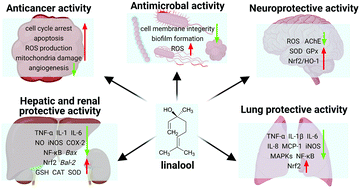Recent updates on bioactive properties of linalool
Abstract
Natural products, including essential oils and their components, have been used for their bioactivities. Linalool (2,6-dimethyl-2,7-octadien-6-ol) is an aromatic monoterpene alcohol that is widely found in essential oils and is broadly used in perfumes, cosmetics, household cleaners and food additives. This review covers the sources, physicochemical properties, application, synthesis and bioactivities of linalool. The present study focuses on the bioactive properties of linalool, including anticancer, antimicrobial, neuroprotective, anxiolytic, antidepressant, anti-stress, hepatoprotective, renal protective, and lung protective activity and the underlying mechanisms. Besides this, the therapeutic potential of linalool and the prospect of encapsulating linalool are also discussed. Linalool can induce apoptosis of cancer cells via oxidative stress, and at the same time protects normal cells. Linalool exerts antimicrobial effects through disruption of cell membranes. The protective effects of linalool to the liver, kidney and lung are owing to its anti-inflammatory activity. On account of its protective effects and low toxicity, linalool can be used as an adjuvant of anticancer drugs or antibiotics. Therefore, linalool has a great potential to be applied as a natural and safe alternative therapeutic.



 Please wait while we load your content...
Please wait while we load your content...